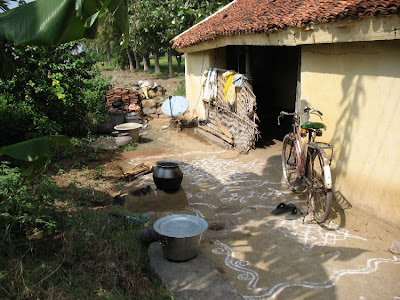Story One:
The Samurai and the Zen Master
A samurai, a very proud warrior, came to see a Zen Master one day. The samurai was very famous, but looking at the beauty of the Master and the Grace of the moment, he suddenly felt inferior. He said to the Master, "Why am I feeling inferior? Just a moment ago everything was okay. As I entered your court suddenly I felt inferior. I have never felt like that before. I have faced death many times, and I have never felt any fear -- why am I now feeling frightened?" The Master said, "Wait. When everyone else has gone, I will answer." People continued the whole day to come and see the Master, and the samurai was getting more and more tired waiting.

By evening the room was empty, and the samurai said, "Now, can you answer me?" The Master said, "Come outside." It was a full moon night, the moon was just rising on the horizon. And he said, "Look at these trees. This tree is high in the sky and this small one beside it. They both have existed beside my window for years, and there has never been any problem. The smaller tree has never said to the big tree, 'Why do I feel inferior before you?' This tree is small, and that tree is big -- why have I never heard a whisper of it?" The samurai said, "Because they can't compare." The Master replied, "Then you need not ask me. You know the answer."
[Author Unknown]Story Two:
Good, Bad or Lucky
“To me, selfishness seems to come out of an instinct for self-preservation, which is our deepest and first instinct. How can we opt for selflessness? It would be almost like opting for non-being. To me, it would seem to be the same thing as non-being. Whatever it is, I’m saying: Stop feeling bad about being selfish; we’re all the same.
Someone once had a terribly beautiful thing to say about Jesus. This person wasn’t even Christian. He said, “The lovely thing about Jesus was that he was so at home with sinners, because he understood that he wasn’t one bit better than they were.” We differ from others—from criminals, for example—only in what we do or don’t do, not in what we are. The only difference between Jesus and those others was that he was awake and they weren’t. Look at people who win the lottery. Do they say, “I’m so proud to accept this prize, not for myself, but for my nation and my society.” Does anybody talk like that when they win the lottery? No. Because they were lucky, lucky. So they won the lottery, first prize. Anything to be proud of in that?
In the same way, if you achieved enlightenment, you would do so in the interest of self and you would be lucky. Do you want to glory in that? What’s there to glory about? Can’t you see how utterly stupid it is to be vain about your good deeds? The Pharisee wasn’t an evil man, he was a stupid man. He was stupid, not evil. He didn’t stop to think. Someone once said, “I dare not stop to think, because if I did, I wouldn’t know how to get started again.”
[Anthony De Mello]










































